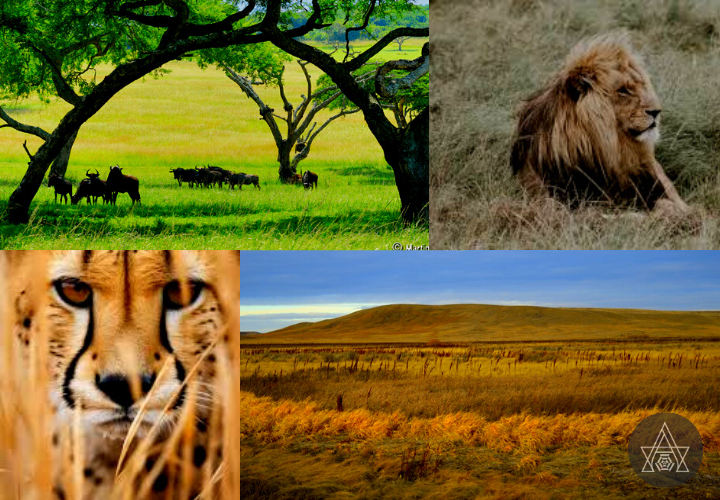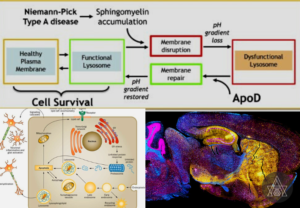Biosphere of the Savanna
Introduction
Savanna grasslands are a type of terrestrial biome with large open spaces and a few small plants and trees. Inside 30° of the equator, all savannah grassland biomes can be found, and they are normally found between deserts and tropical rain forests. Europe, Africa, Asia, and South America are all home to them.
Savannas are typically found at the intersection of a forests and a grassland. This means that while tall trees remain, like in forests, they are spread out and the land of the savannas are covering from grasses, as in a grassland. The weather is also transitional, with dry periods similar to those found in a desert and wet times similar to those found in a rainforest. There is no rain throughout the winter, and the soil is quite dry. It normally rains a lot during the summer.
Because that only rains during a specific season, this is referred to as seasonal rainfall.

Biotic Factors
The living organisms that inhibit in a Savana are the biotic components. Producers, consumers, decomposers are including this category. This Savanna grassland of biotic components made up of varies plants and animal species. Tree, shrubs, grasses are some of producers which produce energy for other living organisms by using sunlight from photosynthesis. There are 3 categories of consumers, those are herbivorous, carnivorous and omnivorous.
Carnivorous – Eat animals
Herbivorous – Eat plants
Omnivorous – Eat both plants & animals
Fungi, bacteria and some insects are examples for the decomposers which breakdown the organic matters. Lions and other cats are examples for the Carnivorous. Elephants, rhinos are examples for the herbivorous. Hoofed animals such as zebra and antelope can found in the Savana grassland. To maintain this savanna ecosystem in balanced by animals rely on one another. Savannas are sensitive ecosystems that rely on grazing animals. Hence the grass avoids from growing too tall, fungi to remove dead debris, and predators to keep the grazing mammal population under control. A wonderful environment for predatory animals to flourish is in the savanna. Bermuda and Elephant grasses also can be observed in the Savana. Isolated trees and scattered shrubs can occur in this ecological system. Giraffes, zebras, gazelles, buffalos, elephants, wildebeests and ostriches are common in the savannas. Vegetation structure can be influenced by mega herbivores and large mammals (mass 45–1000 kg) and (mass greater than 1000 kg). Soil has biotic factors and as well as abiotic factors. Plants grows in the soil and some animals living in the soil. Soil act as a habitat to soil organisms as like warms, bacteria and other microscopic and Water, air and organic matter are biotic factors in the soil.
When compared to the actual biomass of the plants at any one time, savannas have comparatively high of net primary production.

Abiotic Factors
Living organisms always depend upon the nonliving components in ecosystem of savanna grassland. We called these nonliving components to abiotic factors. There are so many abiotic factors in the savanna grassland. Those are soil, climate, natural disturbance, topography, solar energy, sun light, fires, oxygen and other natural gasses and pollution. Soil has abiotic factors. Those are soil texture and minerals etc. The texture of the soil allows to flow the water. The volume and verities of the trees and plants that grows in the savanna grassland are determined by precipitation. The landscape included in a topography of Savanna grassland. Prairies, rivers, rocks, gullies, cliffs, low lying areas and hills are including to landscape. We can occur so many natural disasters in this ecosystem. Some of those are fires and flooding. Fires caused by lightning storms and flooding from streams and rivers. To migrate lot of animals, have long legs and wings. The organisms that live in the Savanna succeed there because they adjusted to the hot-dry climate of the Savanna. Savanna has moderate rainfall regimes. There are dry forest sections mosaicking with dry savannahs in locations with less precipitation patterns.

Population and Community
Savannas encompass around half of the African continent and one fifth of the world’s geographical surface. According seasonality is a distinguishing trait of this ecosystem and the animals and plants that live there are not only evolved to withstand periodic fluctuations, and also demand them. The plants of Savanna go through a longer duration each year. Steady growth is impossible due to a lack of moisture. Even though the shallow-rooted grasses in above ground sections immediately dry out and perish. Deeper-rooted trees may access moisture buried deeper under the surface for extended periods of time during the high temperature dry season. Survive long time of drought as latent tree buds. These buds near to the soil surface. The savannas’ grasses evolved to make it difficult for animals to graze. Some are too harsh or unpleasant for some species to consume, but not for everyone. Various species will consume various portions of the grasses. The secondary advantage is that due to the many sorts of biological functions that an organism has, something to eat every animal which living in this ecosystem. Lot of water hold in a sandy soil during wet seasons. Completely dried out when rain absent. Deep soil layers supply to water to trees even drop their leaves. The trees want vary few amounts of water. Branches of leafless certain species contain open blooms towards the conclusion of the dry period, most trees shed their leaves to decrease water loss through evaporation. The dry season runs each year between three and seven months. This is very significant constraint on plant development. When the weather is exceedingly hot and soil moisture is at its lowest, trees may shed their leaves and new leaves may sprout several weeks before the regular start of the rains. Trees may be able to benefit of early rains as a result of this modification.

Tree flowering and seed production varies significantly, with some plants blossoming at the rainy season’s start, middle, or end of the rainy season. When grass grazing mammals increase the area, the grass may be extinct. Even large numbers of those critters, will not be able to eradicate the woody plants with top branches beyond their grasp. Following regeneration, woody plants will thrive, becoming denser and shifting the vegetation profile from savanna. Between 1934 and 1959, the elephant population in Congo’s Virunga National Park increased steadily, so then increased deforestation resulted in the transformation into a grassy savanna with remain few trees from highly wooded savanna grassland. Tree planting imbalance may be less the fire which destroy the land. Grazing field is frequently rendered worthless due to bush overrunning. It’s a big concern in the drier sections of the savanna, including in, Australia, Venezuela and India.
Savanna animals have evolved to cope with food shortages. Seasonal migrations include several birds and, particularly in Africa, numerous animals. The savanna is home to over 2 million huge plant-eating creatures. The Serengeti Plains are home to 45 animal species, 55 acacia species and about 500 bird species. African wildcats, Lions, steenbok, klipspringer, Burchell’s, puff adders, zebra and African Savanna monitor are among the creatures found there. A tropical grassland with year-round warm temperatures and seasonal rains, the African savanna ecosystem is tropical grassland. A varied population of creatures interact to build a complex food web in the savanna, which is characterized by grasses and tiny or dispersed trees. Soil erosion is frequently accelerated as a result. In heavily populated savanna as an example Africa north of equator, similar processes are related to the form of land deterioration.

From the biotic community of savanna has a great range of creatures. They differ depending on the biotic community’s geographic location. Herbivores including elephants, Oryx rhinos, buffalos, zebras, wildebeests, giraffes, elands, gazelles, warthogs, kudu and impalas sleep on the African grassland. Herbivore concentrations are now mostly linked with African savannahs, although relatively similar animal biomass was probably widespread in all major tropical savannahs until 10–50 000 years ago. In contrast to herbivores, predators flourish in the grassland biotic community due to the number of herbivores. Cheetahs, Lions, jackals, leopards, servals, wild dogs, hyenas and jackals are among the predators present in this grassland biotic community. In discovery of the important trading products, birds and animals travel abroad. Depending on the severity of the drought, the migration might be extensive or short distances. Wildfires are a feature of the season as well. The failure to leave soon enough causes the majority of insects to perish in these flames. Invasive species have the potential to drastically change functions of the ecosystem, fuel loads, and fire patterns, as well as put additional constraints on forest–savannah changes. In particular, incursions appear to be aided in ecotonal settings. The plants are both examples of invading species. The majority of invasive grass species are utilized as feed in pastures. When it comes to precipitation, the tropical grassland biotic community has two different seasons. The rainy season lasts from October through January, with an average rainfall of four inches. The biotic community of grassland receives 2030 inches of rain throughout the wet summer season. Vegetation structure can be influenced by large herbivores and mega herbivores. This impact is exerted through the destruction and opening up of woody vegetation, browsing and trampling of tree seedlings, and grazing of ground layers, all of which can help grasses outcompete tree. Lemongrass, red oat grass, star grass, and Rhode’s grass are just a few of the grass species that thrive in the Savannah area. Trees, pine trees, and palm trees are among the tree species found in the Essay on Savanna

Biome. Regardless, there is a lot of evaporating during this Essay on the community of Savanna Biome, which is greater than the amount of precipitation. They can’t fight the flames; little burrowing creatures are prepared to endure wildfires. Grazers interact with fire regimes and favor woody plants by promoting large-scale seed dissemination via their feces.
Intra and Inter Specific Interactions
In a biosphere of savannah ecosystem, there are various types of interactions. Those are interspecific interactions and intra – specific interactions.
Inter – specific interaction are the interactions between individuals of the different species for, resources, and mating, whereas interspecific interaction is the interactions between members of different species for food or territory and resources.
The most common interactions are between huge predators such as lions and leopards. Herbivores frequently work together. The wildebeest eats the remaining green grass after the zebras have finished eating the long, dry grass. The Gazelle eats the sensitive young growth, which helps to keep the grasslands open. Predators are discouraged of using tall grass for cover. Cheetahs have developed to running after gazelle on wide land, but all other large predators compete fiercely. Cheetahs are built for speed, not strength, and are unable to protect kills from any larger than a wolf or hawk. To defend kills, male cheetahs frequently form big gangs.
Intraspecific interaction occurs when members of same species compete in an ecosystem for same resources such as food, space and nutrients. When the same variety (animal or creature) competes for the same resource, this is known as interspecific competition. That means it’s impossible for a cheetah and an elephant to fight. A hyena vs. vulture competition for food is an example of Inter – specific competition. According to that one of animals to acquire their food, they have to battle each other. And also one of the organisms can survive and receive the food in the end. Two trees planted close together, for example, will fight for sunlight above ground as well as water and soil nutrients. As a result of having fewer resources, they will typically perform worse than if they evolved on their own. Growing taller (particularly in woods) or generating a larger root system are two adjustments to such an environment.
This type of competition does not only occur between animals; it can also occur between plants and trees. A tree known as the Jackal-berry tree grows in the savanna. This is a large, tall tree that receives a lot of light. In order to survive, other trees under the large trees have to compete with it. They’ll have to compete for things like sunshine, water, and a variety of other resources, which the large trees have an advantage over due to its large size.

The Savanna Food Chain
A food chain is a series of individuals that transmit nutrients and energy from one to the next when one eats another. The movement of energy from a individual to the next in an ecosystem is traced via food chains. Food chains are similar to a food webs in that it depicts the movement of food and energy in an environment, but it is considerably smaller and only has one direct connection: single producer, single primary consumer, and also one secondary consumer. Arrows are utilized to symbolize the flow of energy in the environment, indicating in the direction in which the energy is moving. They are linear and simple, but food webs encompass all of an ecosystem’s interwoven food pathways. To ensure that no single individual becomes densely populated within an ecosystem, food webs must achieve a careful equilibrium.
Trophic levels are used to classify organisms in food chains. Always producers are in the first trophic level and then consumers are in the second third and fourth trophic levels. Organisms that produce their own foods are known as producers. Producers are the basis of every food chain.
Organisms that consume the producers make up the second trophic level of a food chain. Primary consumers (mostly herbivores) are these creatures. Herbivores include deer, turtles, and a variety of birds. Herbivores are eaten by secondary consumers. Secondary consumers are eaten by tertiary consumers. Before a chain reaches its top predator, there may be further layers of customers. Apex predators, often known as top predators, prey on other consumers. Consumers might be carnivores (animals who consume other animals) or omnivores (organisms that eat plants and animals) .

The savanna Food Web
The circulation of energy and food through an ecosystem is depicted in a food web. An ecosystem is a term that refers to all living and nonliving things in a given area. A food web can be made up of many different food chains that can be found in many habitats and ecosystems. In a food web, the arrows show what a species eats and where it receives its energy. Grass and small or scattered trees, as well as a wide array of species that interact to produce a complex food chain, characterize the savanna. Carnivores like lions, hyenas, and leopards eat herbivores such as impalas, warthogs, and cattle who eat producers such as grasses and plant matters.
As savannas are grasslands, main producers of the savannas are grass as they make their own energy by photosynthesis. Consumers, also known as heterotrophy, are organisms that must consume other species to obtain energy.
Primary consumers, often known as herbivores or plant eaters, are those who eat only producers. A consumer who eats main consumers is referred to as a secondary consumer. Because it solely eats other animals, the cheetah is classified as a carnivore in this circumstance. Sometimes secondary consumers could be also omnivores if they eat plants. Scavengers also in savanna. Consumers who eat largely dead organisms are known as scavengers. The cheetah’s remnants are then digested by microorganisms, which breaks the animal down and restores the nutrients to the earth.
Tertiary consumers, or animals that consume live secondary consumers, can exist in some food webs. Another animal, such as a lion, might be a tertiary consumer if it came in and kill the cheetah for food. Because they eat dead species rather than living ones, scavengers & decomposers are not classified tertiary consumers.
Organisms that receive their energy from breaking down organic debris are known as decomposers in the savanna. It’s possible that this substance is garbage or decomposing matter.
Most common decomposers – Bacteria and fungus
Creatures that devour dead or rotting organisms are known as scavengers. Scavengers are carnivores since they eat meat, yet the flesh they consume comes from organisms they did not hunt or kill. Vultures and hyenas are two such scavengers in the savanna.

Conclusion
The Savanna is a wonderful part of the planet. Biosphere of the Savanna made up of different kind of things as mentioned above. They at home to many different species, including major species like elephants and endangered species. Predator-prey relationships can be seen all across this area. Those animals live in savannas show specific interaction call inter specific interactions and intra specific interactions. Abiotic and biotic variables have a variety of effects on this ecosystem. Because of the interactions among different species in savannas, food chains and food webs are built. There are many various kinds of species in the savanna habitat. Each of these creatures plays an important role in maintaining the ecosystem’s health. Different trophic levels are assigned to different animals based on how they obtain the energy required to thrive on the savanna. Producers in savanna, such as the grasses, are species that use photosynthesis to manufacture their own food. Consumers of the savanna are animals that must consume another organism in order to obtain energy.






I have not checked in here for some time as I thought it was getting boring, but the last few posts are good quality so I guess I¦ll add you back to my everyday bloglist. You deserve it my friend 🙂